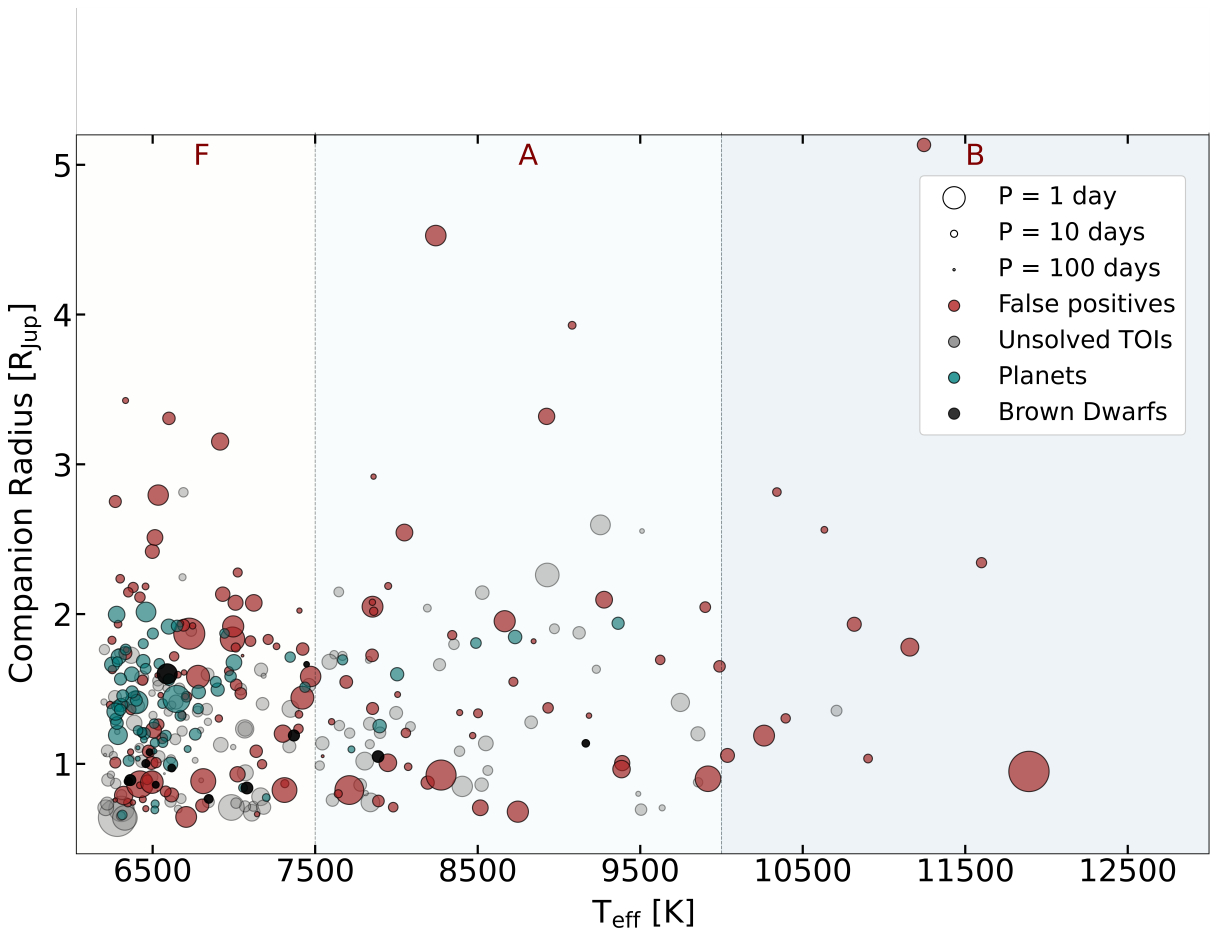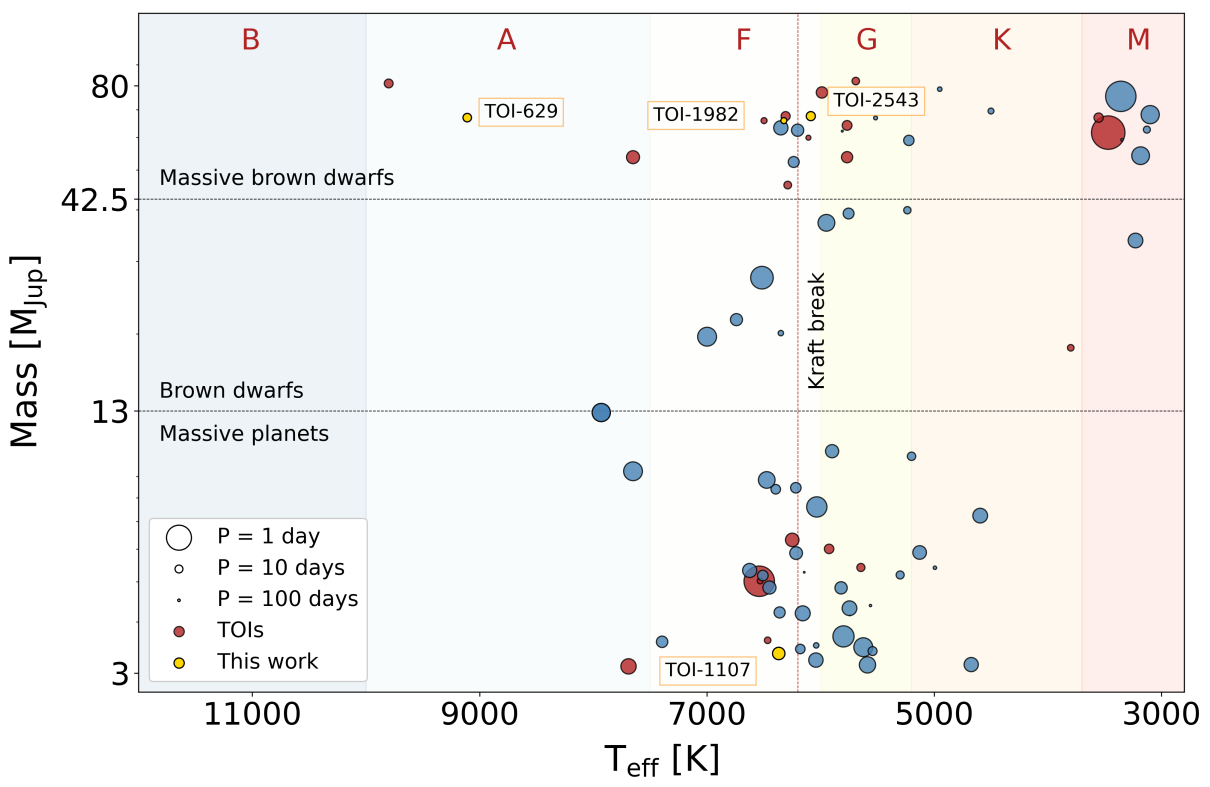Exploring the densities of planets and brown dwarfs transiting hot stars above the Kraft break
- Observatoire de Geneve, University of Geneva, Geneva, Switzerland (angeliki.psaridi@unige.ch)
Even though our understanding of giant planet formation and evolution mechanisms has significantly improved over the past twenty years, the impact of the host star’s properties (mass, temperature, age, and metallicity) on the giant planet distribution remains to be thoroughly studied. The timescales and occurrences of the different planet formation scenarios have to be assessed, quantified, and compared. To that extent, detecting hot Jupiters and brown dwarfs orbiting hot stars is essential if we want to constrain giant planet and brown dwarf formation models across various stellar types and the impact of stellar mass (e.g., core-accretion models predict an increase in gas giant frequency with stellar mass). However, obtaining mass measurements of planets orbiting stars hotter than the Kraft break (6200 K) is inherently more difficult than for Solar-type stars. These stars have thin convective envelopes and do not efficiently generate magnetic winds. As a result, they remain rapidly rotating and due to their high temperature they exhibit fewer spectral lines. Their high rotation velocities lead to a substantial broadening of their observed spectral lines, making RV measurements of hot stars difficult. In addition, stellar activity and pulsations can induce RV variations that can mask or even mimic the RV signature of orbiting exoplanets. In particular, only 20% (99 exoplanets) of transiting exoplanets with precise densities have been detected to orbit AF-type stars with Teff > 6200 K (< F8V). Figure 1 summarizes the scarcity of planets detected around host stars with different stellar types. The vertical line at 6200 K indicates the Kraft break where stars retain their high rotational velocities.
We began a radial velocity follow-up survey in January 2021 with the CORALIE spectrograph to obtain mass measurements (and thus densities) of TESS (Transiting Exoplanet Survey Satellite) Objects of Interest (TOIs). The sample consists of 350 TESS giant planet candidates (R > 7 R⊕) brighter than V = 12 mag. We obtain precise radial velocities with the cross-correlation function (CCF) technique using updated binary masks specifically for hot stars. In this sample we find ~40% are false positives (including stellar binaries), ~20% are planets, and ~4% are brown dwarfs with the remainder yet to be characterised (Figure 2). I will present the statistical findings of our survey and our new detections including three brown dwarf companions, TOI-629b, TOI-1982b, and TOI-2543b, and one massive planet, TOI-1107b (Psaridi et al. 2022, Figure 3). Both TOI-1107b and TOI-1982b present an anomalously inflated radius with respect to the age of these systems. TOI-629 is among the hottest stars with a known transiting brown dwarf. TOI-629b and TOI-1982b are among the most eccentric brown dwarfs. The massive planet and the three brown dwarfs add to the growing population of well-characterized giant planets and brown dwarfs transiting AF-type stars and they reduce the apparent paucity.
Furthermore, we acquired 10 nights on the HARPS spectrograph during P108 to further characterise planet candidates in the Saturn regime transiting fast rotating stars with Teff > 6550 that require higher precision and efficiency. This program ended in the discovery of several planetary discoveries including TOI-615b, TOI-622b and TOI-2641b (Psaridi et al. in prep), three Saturn-mass planets orbiting stars above the Kraft break (Figure 4).
Figure 1: Number of known exoplanets with precise mass and radius measurements (σM/M ≤ 25% and σR/R ≤ 8%) as a function of stellar effective temperature. The black vertical line at 6200 K indicates the Kraft break.

Figure 2: Companion radius over stellar effective temperature Teff diagram for our TESS sample. The red circles display the confirmed false positives (including SB1, SB2, blends etc), the blue circles display the confirmed planets and the black circles diplay the confirmed brown dwarfs. The grey circles display TOIs that have not yet been solved. The size scales inversely with the period of the companion.

Figure 3: Companion mass over stellar effective temperature Teff diagram for massive planets (MP > 3 MJup) and transiting brown dwarfs shown in blue. The four new companions are shown in yellow. The red circles display confirmed companions detected by TESS. The size scales inversely with the period of the companion. The red, vertical line corresponds to the Kraft break (6200 K) while the horizontal lines correspond to the approximate boundaries of the brown dwarf regime (13 MJup) and the transition to high-mass brown dwarfs (42.5 MJup). Figure from Psaridi et al. 2022.

Figure 4: RVs from CORALIE (black) and HARPS (orange) with Keplerian model showing the detection of three Saturn-mass planets transiting F-type stars. The errobar in blue displays the photon noise and in red the photon noise plus the stellar jitter.
How to cite: Psaridi, A., Bouchy, F., Lendl, M., and Grieves, N.: Exploring the densities of planets and brown dwarfs transiting hot stars above the Kraft break, Europlanet Science Congress 2022, Granada, Spain, 18–23 Sep 2022, EPSC2022-643, https://doi.org/10.5194/epsc2022-643, 2022.

